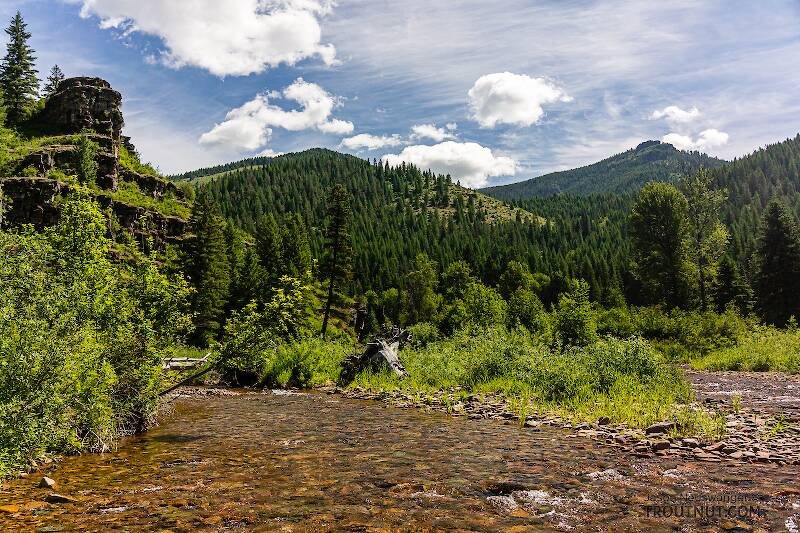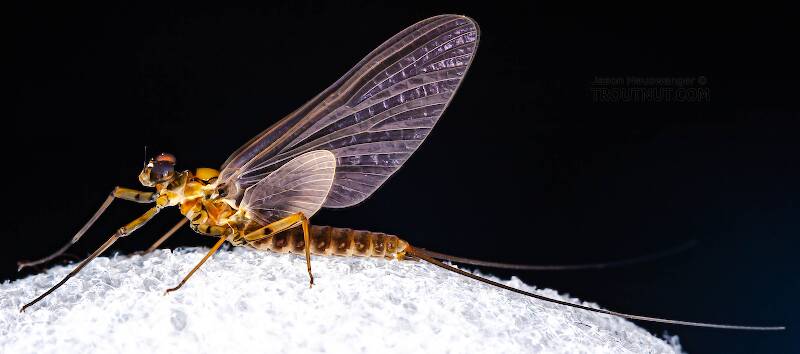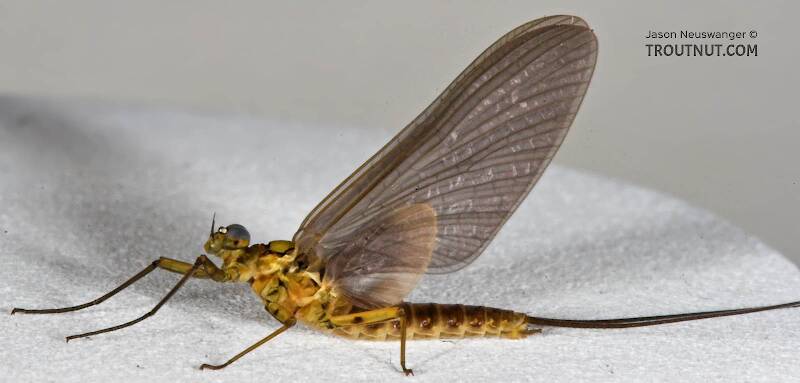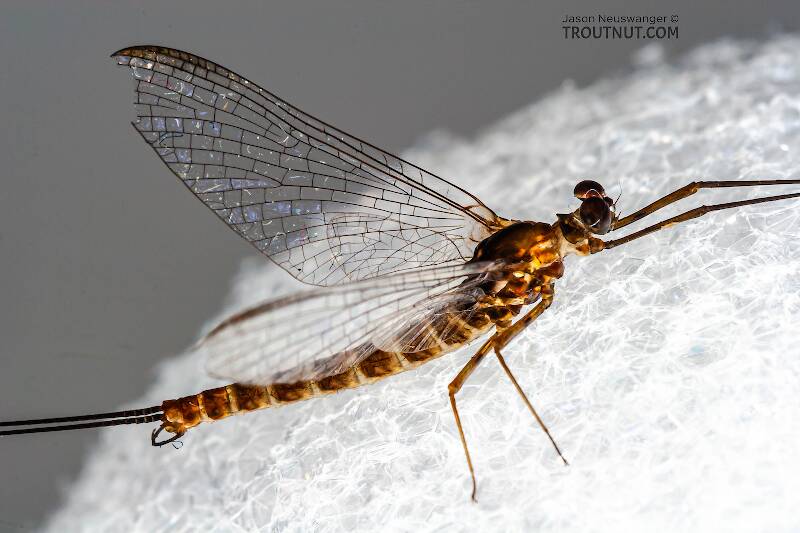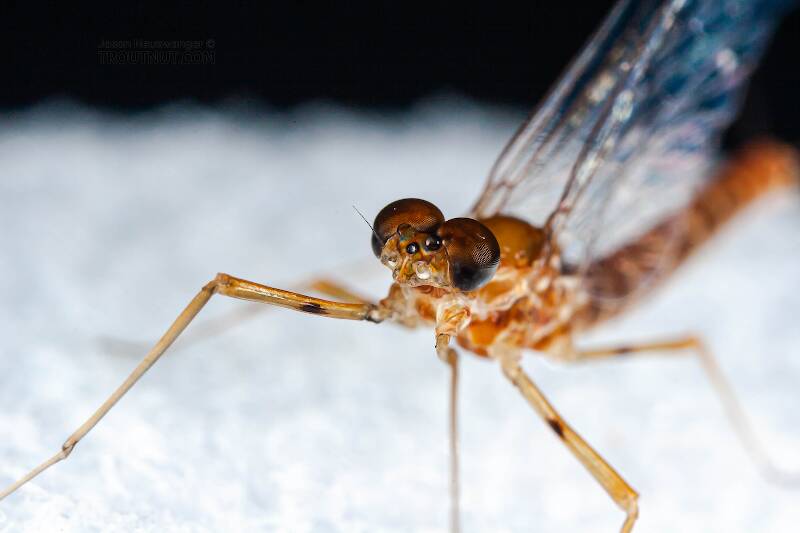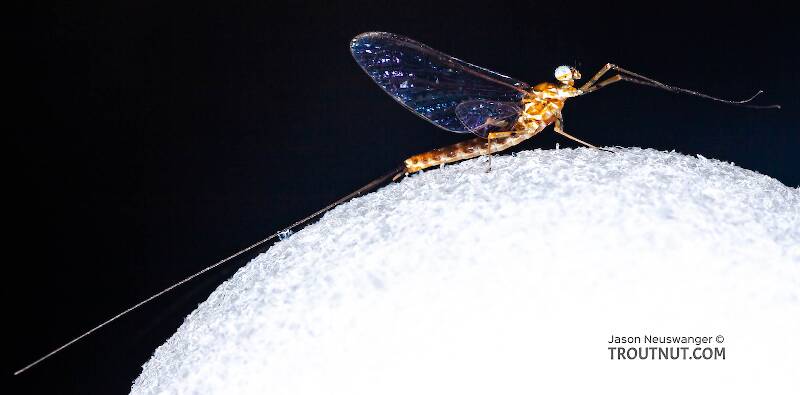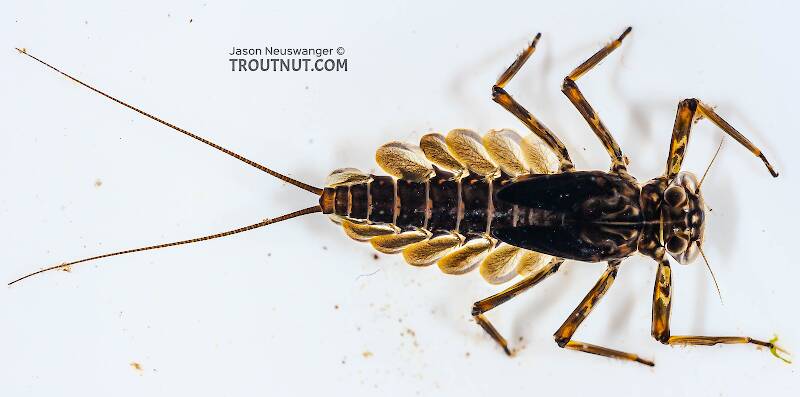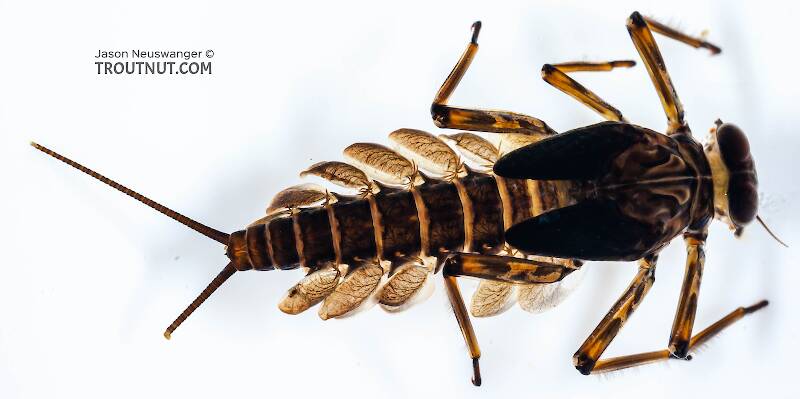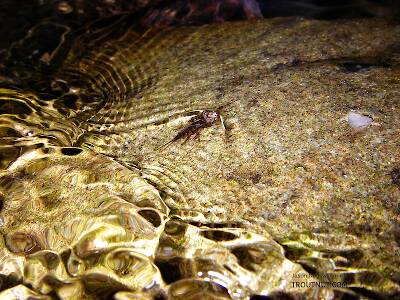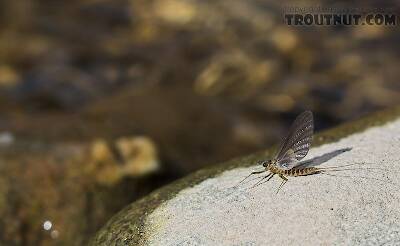
Salmonflies
Pteronarcys californica
The giant Salmonflies of the Western mountains are legendary for their proclivity to elicit consistent dry-fly action and ferocious strikes.


Mayfly Species Epeorus pleuralis (Quill Gordons)
Where & when
The Quill Gordon hatch begins in early April in central Appalachian streams and moves into southern Pennsylvania by mid-April. By early May it is going strong in the Catskills, and it lingers through the rest of May in the Adirondacks and New England.Some books report that this species occurs in the East and the Midwest, though I have not found any accounts of fishable hatches in the Midwest and they are not reported there by the USGS.
Once the pleuralis hatch is triggered by several consecutive days of ideal water temperature, it carries a sort of momentum. The duns supposedly continue to hatch almost every day, regardless of weather, until they are all done.
In 42 records from GBIF, adults of this species have mostly been collected during June (38%), May (36%), and April (10%).
In 7 records from GBIF, this species has been collected at elevations ranging from 440 to 2441 ft, with an average (median) of 1959 ft.
Species Range
Hatching behavior
It is best fished by casting upstream, allowing it to sink, and then twitching it up through the currents in front of feeding fish.
Once the duns are up, they may ride the surface for a long time and make several failed attempts before getting airborne. Skittering a dry fly accordingly may improve one's success.
Spinner behavior
Time of day: Anytime between noon and dusk, depending on temperature
Habitat: Riffles and rapids
These spinners can provide good fishing, especially in pocket water in the rapids where they fall spent.
Nymph biology
Current speed: Fast
Substrate: Gravel or rock
Environmental tolerance: Very intolerant of pollution or slow water
Epeorus pleuralis Fly Fishing Tips
In the cold water of the early season when the Quill Gordons hatch, the trout may not yet rise freely. Although this hatch can provide good dry fly action, you should not hesitate to fish subsurface.Physical description
Most physical descriptions on Troutnut are direct or slightly edited quotes from the original scientific sources describing or updating the species, although there may be errors in copying them to this website. Such descriptions aren't always definitive, because species often turn out to be more variable than the original describers observed. In some cases, only a single specimen was described! However, they are useful starting points.
Male Spinner
Wing length: 10-11 mm
A reddish brown species; cross veins of basal costal space indistinct; genitalia of pleuralis type (now a synonym of Epeorus pleuralis), having long prominent lateral spine on each side of penes.
A paratype of this species presented to the Cornell collection by Dr. Banks, is the basis for this description. Several other specimens in Dr. Banks’ collection, taken at the same time and place and associated with I. pleuralis, prove to be Rhithrogena jejuna, as indicated by Dr. Banks’ notes in his correspondence with us, and by a specimen which he kindly lent us for study. It is probable that the original description included both this species and R. jejuna.
Head of male reddish brown; no distinct markings. Thorax quite uniform dark red-brown; pronotum shaded with smoky brown except on anterior margin. No such distinct paler markings anterior to wing root and on pleura, as indicated in original description. Legs pale reddish brown. Fore leg longer than body. Basal fore tarsal joint subequal to second, third almost, as long. A prominent black spot near median area of each femur. Apical margin of each trochanter very narrowly blackish; faint indications of a small darker spot at each apical angle. Basal joint of hind tarsus slightly longer than second joint. Middle and hind tarsi somewhat darker than their respective tibiae. Wings hyaline, seemingly with very faint yellowish tinge; hardly darker in stigmatic area. (Original description does not mention yellowish tinge, but states, “rather darker in costal area near the tip.” Discrepancy may be due to fact that paratype bas been in alcohol presumably since date of capture). Basal costal cross veins very faint; about 6 before the bulla. Four or five immediately following bulla are likewise very faint. Stigmatic cross veins heavier, distinct; about 14 in number. Venation light brown; longitudinal veins very slightly heavier than cross veins.
Abdominal segments 2-8 semi-hyaline; 9 and 10 largely opaque. Light reddish brown in color, with a yellow tinge; tergites barely darker than sternites. Tergites 2-7 with a paler brownish median area, short submedian streaks from anterior margin which may coalesce with the pale median streak; anterior margins and antero-lateral angles likewise paler brown. A distinct blackish streak at spiracular area, extending from posterior margin in a curve to the pleural fold, cutting off postero-lateral angle. Small pale brownish spot faintly indicated at ganglionic area of each sternite. Penes with two dorsally-directed lobes (best seen in side view) apically near median area; below these on dorsal side, a curved chitinized structure; on each side, a prominent laterally-directed spine-like process (see fig. 106). Distinctly different from genitalia of the longimanus type (now a synonym for Epeorus longimanus); adults may be readily confused with species of the latter type in their general appearance.
Described as I. confusus
Body length 9-10 mm, wing length 10-11 mm
A light reddish brown species, paler than I. fraudator (now a synoynm of Epeorus pleuralis) but darker than fragilis; genitalia of the longimanus type (now a synonym for Epeorus longimanus).
Head and thorax light red-brown. A dark spot above fore coxa; dark red-brown areas on pleura above and between middle and hind legs; very faint blackish pencilings above middle and hind coxae. Legs light red-brown; a conspicuous black mark at center of each femur; apex of fore tibia and all tarsal joinings narrowly dark brown. Wings hyaline; venation very pale brown; basal costal cross veins pale, indistinct.
Abdominal tergites more or less extensively tinged with light reddish brown; anterior margin pale yellowish; posterior margins narrowly but distinctly blackish. Sternites yellowish, more or less shaded with reddish in middle areas. Tails light yellow-brown, very indistinctly darker at joinings.
Described as I. fraudator
Body length 9-10.5 mm, wing length 10-11 mm
A dark reddish brown species, very similar in general appearance to I. pleuralis (now a synonym of Epeorus pleuralis); genitalia of the longimanus type (now a synonym of Epeorus longimanus).
Head and thorax dark red-brown; reddish tinges around bases of antennae and on thoracic pleura. Pronotum heavily shaded with blackish; a black streak from lateral margin of pronotum downward to base of fore leg. A narrow pale yellowish streak anterior to wing roots; a few yellowish markings on pleura below wing roots und above bases of legs. Lateral areas on each side of scutella of mesothorax and metathorax blackish. Legs yellowish to olive brown; fore leg distinctly smoky. Prominent black spot near middle of each femur. Apex of fore tibia blackish. Distal joint of fore tarsus, and all joints of middle and hind tarsi, deep smoky to blackish brown. Wings hyaline; venation dark brown; faint brownish stain in stigmatic area. Basal costal cross veins rather indistinct; 12 to 14 in stigmatic area.
Abdominal tergites dark red-brown. Anterior margins, antero-lateral angles, an irregularly oval area near each spiracle, and submedian streaks based on anterior margin, yellow to pale yellowish brown. A pale narrow median line on tergites 2-7. Sternites paler; anterior margins yellowish, remaining portions flushed with pale red-brown. Tails dark brown. Forceps base light red-brown; forceps and penes darker. Penes very similar to I. longimanus, but with the lateral and apical lobes more distinct because more deeply dissected (see fig. 105).
Female Spinner
Wing length: 10-11 mm
Female very similar to male, except for usual differences; venation somewhat darker brown.
Described as I fraudator
Body length 9-10.5 mm, wing length 10-11 mm
Female very similar to male. Yellowish areas on pleura more extensive. Thoracic sternum largely yellowish, except posterior portion of mesosternum, which is red-brown. Basal costal cross veins more distinct than in male.
Nymph
Postero-lateral spines of nymph short and blunt; femoral flange blunt; gills of first pair with large anterior lobes, which do not quite meet beneath body. No dark submedian spots on tergites. A dark lateral mark on each sternite; 7-9 with small dark submedian triangles at anterior margin.
Described as I fraudator
Nymph as described by Dr. Ide. Anterior lobes of first pair of gills do not quite meet beneath body of nymph. A pair of submedian blackish spots is usually present near middle of each tergite.
Specimens of the Mayfly Species Epeorus pleuralis
2 Male Duns
1 Female Dun
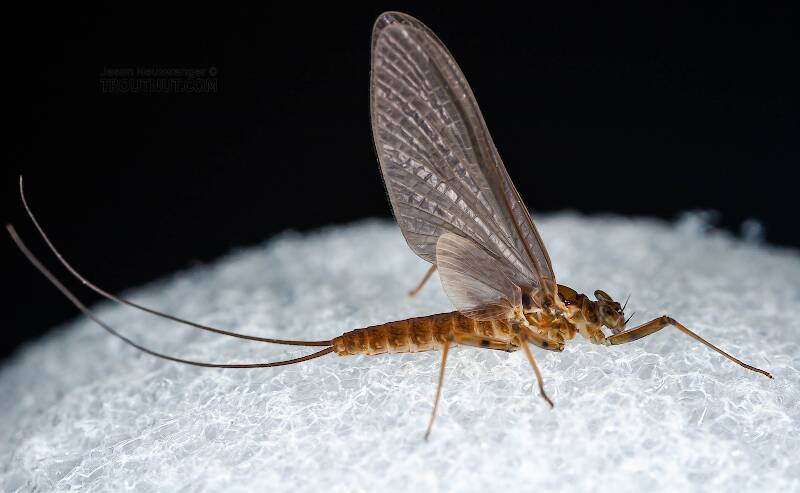
3 Male Spinners
2 Nymphs
2 Streamside Pictures of Epeorus pleuralis Mayflies:
Start a Discussion of Epeorus pleuralis
References
- Arbona, Fred Jr. 1989. Mayflies, the Angler, and the Trout. Nick Lyons Books.
- Burian, Steven K., Swartz, Beth I., Wick, Philip C. 2008. Taxonomy of Epeorus Frisoni (burks) And a Key to New England Species Of Epeorus. International Advances in the Ecology, Zoogeography, and Systematics of Mayflies and Stoneflies undef(undef): 276-294.
- Caucci, Al and Nastasi, Bob. 2004. Hatches II. The Lyons Press.
- Fauceglia, Ted. 2005. Mayflies . Stackpole Books.
- Knopp, Malcolm and Robert Cormier. 1997. Mayflies: An Angler's Study of Trout Water Ephemeroptera . The Lyons Press.
- Needham, James G., Jay R. Traver, and Yin-Chi Hsu. 1935. The Biology of Mayflies. Comstock Publishing Company, Inc.
- Schwiebert, Ernest G. 1955. Matching the Hatch. MacMillan Publishing Company.
- Swisher, Doug and Carl Richards. 2000. Selective Trout. The Lyons Press.
Mayfly Species Epeorus pleuralis (Quill Gordons)
Species Range
Resources
- NatureServe
- Integrated Taxonomic Information System
- Global Biodiversity Information Facility
- Described by Banks (1910)

